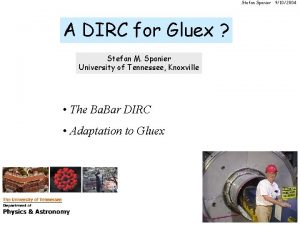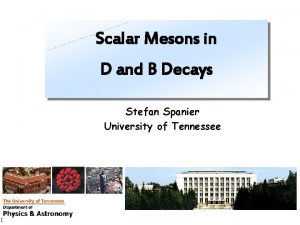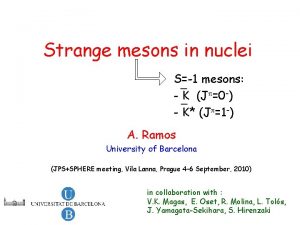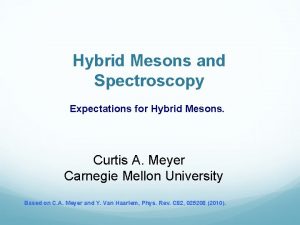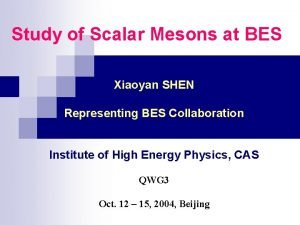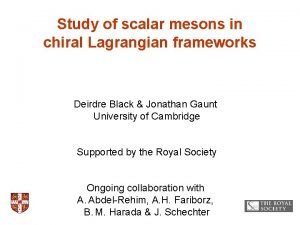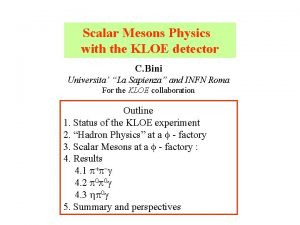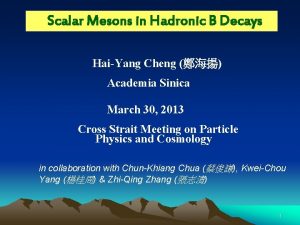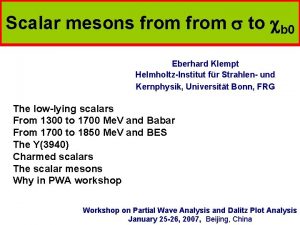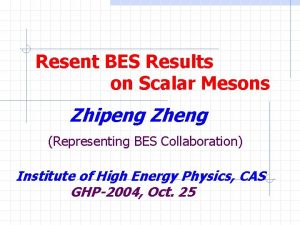The Scalar Mesons Proposal Stefan Spanier University of









![• I=1/2 Scalar E 791 [Edera, Pennington: hep-ph/0506117] … but differs from LASS • I=1/2 Scalar E 791 [Edera, Pennington: hep-ph/0506117] … but differs from LASS](https://slidetodoc.com/presentation_image_h2/5864670f9c85c9f6248577eaf461a74f/image-10.jpg)

- Slides: 11

The Scalar Mesons Proposal Stefan Spanier University of Tennessee, Knoxville PDG Collaboration meeting 10/10/2008 CERN, Geneva Scalar Meson Review: Claude Amsler, Nils Tornqvist, Stefan Spanier, Scalar Mesons, PDG Meeting 2008 1

• Scalar Mesons are special below 2 Ge. V Present a long standing puzzle Measurements of phase motions since 1970 s • Quantum number of vacuum – fundamental role in chiral symmetry breaking _ _ • Glueball mixtures: a nn + b ss + c qqqq + d glue + • Low receiving end of hadronic reactions • Experimental Challenges: - Broad states - Strongly overlapping - Close to several thresholds - Extra dynamical features (left-hand cuts, Adler zero) - Featureless angular distributions (like background) - Often covered by tensor or/and vector mesons Stefan Spanier, Scalar Mesons, PDG Meeting 2008 2

• Scalar Meson Spectrum 2+ Stefan Spanier, Scalar Mesons, PDG Meeting 2008 3

• Model Dependent Analysis No simple Breit-Wigner fits combined sample analysis coupled channel analysis d ol sh _ re need both to piece puzzle together th Static models Dynamics: production decay T 11 [EP A 16, 229 (2003)] I=0 (pp) S-Wave f 0(980) f 0(1370) KK Non-perturbative regime 2 s(600) ? f 0(1500) • Do not describe with individual resonances but parameterize complete (partial wave) amplitude • In optimum case the underlying resonances show up as same poles in the unphysical sheet of the complex energy plane evaluate denominator of complex amplitude for singularities Stefan Spanier, Scalar Mesons, PDG Meeting 2008 4

• Formalism Try to start from dominance by 2 -body interaction Dynamic amplitude requirements: - Lorentz invariant - 2 -body Unitarity - Analytic / Crossing 2 -body scattering a l c R R = (1 -i. Kr)-1 l r = 2 -body PS d l d b e. g. c R production / decay T=RK In very formal way using K-matrix L Spectator ? F=RP =QT P-vector Q-vector • Watson theorem: same phase motion in T and F in elastic range • Adler zero: at mp 0 for pp=0: T = 0 near threshold; also/where for F ? • K-matrix poles % T-matrix poles in unphysical sheet of complex energy plane Stefan Spanier, Scalar Mesons, PDG Meeting 2008 5

• I=1/2 Scalar Kp Scattering LASS Data from: K-p+n • Most information on K-p+ scattering comes from the LASS experiment (SLAC, E 135) • Disentangle I=1/2 and I=3/2 with K+p+ and K-p K 0 p-p [NPB 133, 490 (1978)] NPB 296, 493 (1988) Phase (degrees) 150 Pennington Ch. PT compliant 100 50 0 LASS parameterization -50 0. 7 0. 9 1. 1 1. 3 MKp (Ge. V) 1. 5 0. 7 0. 9 1. 1 MKp (Ge. V) 1. 3 1. 5 Kh’ threshold No data below 825 Me. V/c 2 • use directly in production if re-scattering is small • require unitarity approach … Stefan Spanier, Scalar Mesons, PDG Meeting 2008 6

• I=1/2 Scalar LASS experiment used an effective range expansion to parameterize the low energy behavior: q cot d = 1 ___ 2 am ______ 2+ab q 2 d: scattering phase a: scattering length b: effective range q: breakup momentum 2 K-1 = r cot d Turn into K-matrix: K = + a 2 b q ______ + g 0 _____ m 02 – m 2 and add a_ pole term (fits also pp annihilation data) Both describe scattering on potential V(r) (a, b predicted by Ch. PT) Takes left hand cuts implicitly into account Instead treat with meson exchange in t- (r ) and u-channel (K* ) [JPA: Gen. Phys 4, 883 (1971), PRD 67, 034025 (2003)] only K 0*(1430) appears as s-pole same phase motion, different parameterization / pole pattern Stefan Spanier, Scalar Mesons, PDG Meeting 2008 7

• I=1/2 Scalar D+ (K-p+) m+ nm FOCUS Reconstructed events: ~27, 000 c D+ W+ s Kp+ • Kp system dominated by K*(892) • Observe ~15% forward-backward asymmetry in Kp rest frame • Hadronic phase of 45 o corresponds to I=1/2 Kp wave measured by LASS required by Watson theorem in semileptonic decay below inelastic threshold • S-wave is modeled as constant (~7% of K*(892) Breit-Wigner at pole). a phase of 90 o would correspond to a kappa resonance, but … Study semileptonic D decays down to threshold ! [PLB 621, 72 (2005)] Stefan Spanier, Scalar Mesons, PDG Meeting 2008 [PLB 535, 43 (2002)] 8

• I=1/2 Scalar W+ p+ D+ E 791 • Fit with Breit-Wigner (isobar model): K- Mk = (797 19 42) Me. V/c 2 Gk = (410 43 85) Me. V/c 2 K- p+ p+ p+ W+ D + K -p + #15090 [PRL 89, 121801 (2002)] • Fit with Breit-Wigner + energy- independent fit to Kp S-wave (P(K*(892), K*(1680)) and D-waves (K*2(1430))act as interferometer) Model P- and D-wave (Beit-Wigner), S-wave A = ak eifk bin-by-bin (40) [PR D 73 (2006) 032004] Extracted phase motion from both analyses are similar. K*(892) K*(1430) Stefan Spanier, Scalar Mesons, PDG Meeting 2008 9
![I12 Scalar E 791 Edera Pennington hepph0506117 but differs from LASS • I=1/2 Scalar E 791 [Edera, Pennington: hep-ph/0506117] … but differs from LASS](https://slidetodoc.com/presentation_image_h2/5864670f9c85c9f6248577eaf461a74f/image-10.jpg)
• I=1/2 Scalar E 791 [Edera, Pennington: hep-ph/0506117] … but differs from LASS elastic scattering • Quasi-two body Kp interaction (isobar model ) broken ? if not • Watson theorem does not apply ? -75 o Kh’ threshold • Isospin composition I=1/2 % I=3/2 in D decay same as in Kp ? Q-vector approach with Watson: if not |FI | A(s) eif(s) = F 1/2(s) + F 3/2(s) , s = m. Kp 2 I FI(s) = QI(s) T 11 (s) eib. I s – s 0 I T 11 from LASS ( same poles ? ) Constraint: Q smooth functions Adler zero s 0 I removed Stefan Spanier, Scalar Mesons, PDG Meeting 2008 big ! 10

• Summary - Role that PDG can play … • Pole structure of the amplitude in complex energy plane PDG table • Isospin amplitude for 2 -body scattering is as important - Data on phase motion and modulus (or/and elasticity) - Parameterizations (limited number) Compare on level of 2 -body scattering (unitarity, analyticity) phase motion and modulus often in close agreement, but underlying parameterization and/or pole structure different Increase confidence with combined data-set coupled channel analyses increase constraints; updates extract iteratively the bare 2 -body wave Provide input for analyses that include scalars (likelihood analyses) Example: Input for B CP – physics - B 0 J/y K* study Kp mass from 0. 8 – 1. 5 Ge. V/c 2 - add penguin modes for New Physics Search, e. g. B 0 f 0 K 0 - CP composition of 3 -body modes, e. g. B 0 K 0 K+K- hadronic phase for CP angle g in B DK from D-Dalitz plot • Proposal: Archive (pdglive) scalar amplitude information. Stefan Spanier, Scalar Mesons, PDG Meeting 2008 11












